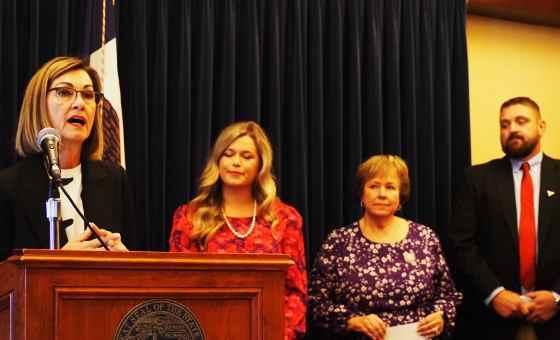Gov. Kim Reynolds said Wednesday her administration’s efforts to implement “science of reading” and math education efforts have resulted in higher scores for Iowa students on national assessments.
Reynolds and school officials held a news conference to celebrate the recent gains for Iowa on the National Assessment of Educational Progress (NAEP), used to rate student progress around the country. Reynolds said Iowa students’ scores have returned to pre-pandemic proficiency levels in reading, writing and math, and have exceeded previous levels in science.
Reynolds said these improvements showcase why she believes President Donald Trump and U.S. Education Secretary Linda McMahon’s plan to send funding directly to states instead of going through the federal Department of Education — a proposal opposed by many education groups — would better serve K-12 schools.
“That’s why we submitted the first-in-the-nation unified allocation plan to really align federal programs and resources to Iowa’s state and local education priorities, to bolster school improvement efforts informed by accountability and assessment and support school districts,” Reynolds said. “… With today’s good news, we’re proving that I think we’re up to the task, that we’re definitely on the right track, that we have put the infrastructure in place, that we really are ready and able to take that opportunity and continue strong partnership to move this state forward.”
Reynolds and Iowa Department of Education Director McKenzie Snow linked the NAEP score increases to measures signed into law on reading in 2024 and math in 2025 that provide support for schools, teachers and families that have students struggling in these subjects. The 2024 law focused on children in kindergarten through sixth grade who are not reading at grade-level proficiency, giving these students a personalized plan to assist them until they meet literacy benchmarks.
The most recent NAEP test scores show an 11% increase in reading proficiency among students who were in 3rd grade in the 2023-2024 school year when they were tested again as 4th graders in 2024-2025, according to state officials.
“And just three months ago, I signed the ‘Math Counts’ bill into law, which we believe will replicate our success in literacy,” Reynolds said. Because while math scores are increasing in elementary and middle school, our high schoolers are really lagging behind.”
The law signed this year takes a similar approach to mathematics instruction, providing early screening and targeted intervention strategies for K-12 students who are struggling with the subject, in addition to boosting math teaching resources for families and school staff.
The officials also said chronic absenteeism rates have fallen significantly in recent years. Snow said the average percentage of chronically absent students – defined as those who miss 10% or more of classes in a year – dropped 5.8 percentage points in the last year. That, combined with other improvements for schools in need of support and increased work-based learning attainment, show significant progress for Iowa student achievements, she said.
“Overall school performance is improving,” Snow said. “Schools in need of support are improving, early literacy is improving, science proficiency is improving, attendance is improving and work-based learning is growing. … Our continued commitment to evidence based practices. Instructional leadership and accountability is imperative, and we’re excited to build on this remarkable progress together.”
T.J. Schneckloth, superintendent of Davenport Community School District, said the education department and state Legislature’s work on addressing absenteeism has made a major impact in Davenport schools.
“Our chronic absenteeism has drastically reduced in Davenport, and a lot of that has to do with some of the teeth that’s put into that legislation,” Schneckloth said.
Senate File 2435, the state’s education appropriations bill in 2024, changed regulations regarding absenteeism and truancy for Iowa students, including having school districts notify county attorneys alongside parents and guardians when a student misses 10% of hours in a trimester, and sets up a procedure for creating an “absenteeism prevention plan” with parents and students. If a student misses 20% of nonexempt hours during a trimester or if they and their parents are found violating the agreed-upon plan, the county attorney is notified.
Schneckloth also said the law signed by Reynolds in April that required K-12 public school districts to adopt policies banning at minimum the use of cellphones during instructional periods beginning in the 2025-2026 school year has also had a major, positive impact.
When student representatives on the Davenport school board were asked about the cell phone policy, he said “you took you heard a sigh, because obviously kids would like to have their phones with them all the time.”
“But unanimously, all the way around, every one of those juniors and seniors said, ‘I’m more focused in class,’ and ‘I find, instead of going to my phone, I’ll start a conversation with person next to me,'” Schneckloth said. “And so that level of engagement is exactly what we hear when we travel around and talk to our businesses — ‘we want people show up and we want them to care while they’re there.'”

Comments
Submit a CommentPlease refresh the page to leave Comment.
Still seeing this message? Press Ctrl + F5 to do a "Hard Refresh".